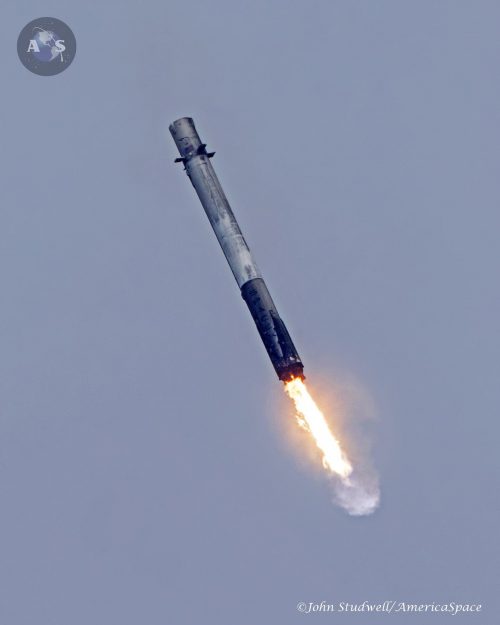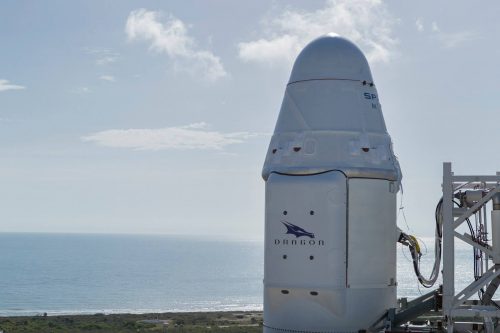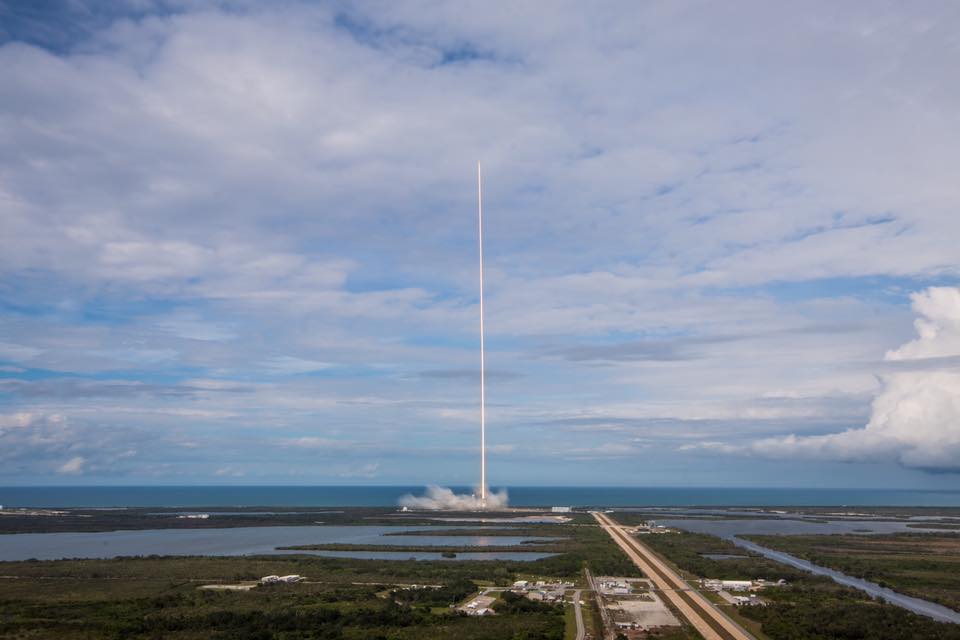
The CRS-11 Falcon 9 first stage returns to Earth, making a successful landing back at Cape Canaveral AFS after launching Dragon to the ISS minutes earlier from KSC pad 39A. Photo Credit: NASA TV
If candles celebrate an anniversary, then the roar of Merlin 1D+ rocket engines honored the 100th launch from Pad 39A at the Kennedy Space Center (KSC) in Florida, earlier today (Saturday, 3 June). SpaceX’s Upgraded Falcon 9 booster roared aloft from the historic complex at 5:07 p.m. EDT, precisely on the cusp of an “instantaneous” launch window. The launch occurred on the second attempt, following a scrub less than a half-hour before Thursday’s planned attempt, due to lightning in the KSC area.
Less than eight minutes after leaving the pad—which has supported 82 Space Shuttle launches, including the first and last missions in the 30-year program, as well as the first flight to assemble the International Space Station—three more historic events transpired: the injection of the ISS-bound CRS-11 Dragon cargo ship into low-Earth orbit, the first reflight of a “used” Dragon and the pinpoint touchdown of the Upgraded Falcon 9’s first stage on Landing Zone (LZ)-1, approximately nine miles (15 km) away from Pad 39A.
Pad 39A has seen use over the last five decades for many of the grandest adventures ever undertaken by humans in space. First utilized for the maiden launch of the Saturn V in November 1967, it went on to serve as the staging-point for the first manned voyage to lunar orbit in December 1968 and the triumphant planting of U.S. boots on the Moon in July 1969. All told, the pad hosted 12 Apollo-era missions, bookended by the launch of America’s Skylab space station in May 1973, after which it was extensively modified for the Space Shuttle program. Between April 1981 and July 2011, it supported the maiden launches of shuttles Columbia, Challenger, Discovery and Atlantis.
Following the retirement of the shuttle fleet, NASA handed Pad 39A over to SpaceX on a 20-year lease in April 2014 for Falcon 9 operations. Between February 2017and tonight’s mission, the Hawthorne, Calif.-headquartered launch services organization—headed by entrepreneur Elon Musk—has staged six flights from the historic complex. These have delivered two Commercial Resupply Services (CRS) Dragon missions to the ISS, together with three powerful communications satellites to Geostationary Transfer Orbit (GTO) and the top-secret NROL-76 payload for the National Reconnaissance Office.
Having already pioneered the reusability of its Upgraded Falcon 9—one of whose recovered first stages was successfully launched a second time on 30 March 2017—tonight’s mission marked the first-ever reflight of a Dragon. The CRS-11 pressurized cargo module had previously launched on the ISS-bound CRS-4 flight, back in September 2014, splashing down in the Pacific Ocean five weeks later and receiving extensive modification in support of another voyage. Under the terms of the original $1.9 billion Commercial Orbital Transportation Services (COTS) agreement with NASA, signed in December 2008, SpaceX was required to launch a “new” Dragon on each of its 12 contracted cargo supply missions to the space station. Kicking off with a Demonstration flight in May 2012, the first dedicated mission occurred the following October and SpaceX has since flown an average of two Dragons per annum to successive ISS crews.
In January 2016, NASA selected its current CRS partners SpaceX and Orbital ATK, together with Sierra Nevada Corp., to fulfil a follow-on CRS-2 series of resupply missions from 2019 through the anticipated end of ISS operations in December 2024. Last fall, Space Newshighlighted that reusing previously flown hardware would allow SpaceX to close down its first-generation Cargo Dragon production line and bring the next-generation Dragon-2 (or Crew Dragon) spacecraft to operational readiness.
All told, 5,970 pounds (2,708 kg) of payloads and supplies are riding to orbit aboard Dragon for CRS-11. Almost half of this amount comprises scientific experiment hardware for Expedition 52, together with smaller quantities of crew supplies, vehicle hardware, spacewalking gear and computer resources. Major research payloads include the Roll-Out Solar Array (ROSA), the Neutron Star Interior Composition Explorer (NICER) and the Multiple User System for Earth Sensing (MUSES).
Last Sunday, as is customary before each mission, the 230-foot-tall (70-meter) Upgraded Falcon 9 underwent a Static Fire Test of the nine Merlin 1D+ first-stage engines, which raised a thunderous roar, a cloud of smoke and a yield of 1.5 million pounds (680,000 kg) of thrust. The booster was then returned to a horizontal configuration and returned to the nearby integration facility, where the CRS-11 Dragon cargo ship was installed, preparatory to an opening launch attempt on Thursday, 1 June.
The weather outlook was predicted to be marginal, with a 70-percent likelihood of acceptable conditions at T-0. “Moisture has begun to build in aloft today, signaling the start of Central Florida’s convective season,” noted the 45th Weather Squadron at Patrick Air Force Base in its L-2 briefing on Tuesday morning. “The storms will be guided by the orientation of the Bermuda Ridge axis, which is forecast to gradually shift north of the Spaceport over the next few days.” It was expected that the Bermuda Ridge axis would steer most inland storms away from KSC by Thursday, although upper-level winds were predicted to bring anvil clouds eastwards, creating a potential violation of the Cumulus Cloud Rule and Anvil Cloud Rule.

Falcon 9 soars with Dragon CRS-11 for the ISS. The booster landed a few miles south of KSC pad 39A just a few minutes later. Photo Credit: John Studwell / AmericaSpace
It was reported that a scrub on Thursday would lead to a 48-hour turnaround and a second launch attempt on Saturday evening, where the risk level increased to a 60-percent likelihood of acceptable conditions, with concerns centering on the presence of anvil and cumulus clouds, together with a chance of violating the Flight Through Precipitation Rule. This was expected to deteriorate to just 50-percent favorable in the event of a delay to Sunday, 4 June.
Marching towards its opening CRS-11 launch attempt on Thursday evening, the loading of propellants aboard the Upgraded Falcon 9 got underway about an hour before T-0, with a highly refined form of rocket-grade kerosene (known as “RP-1”). “Vapor plumes can be seen streaming from the rocket as it stands on the launch pad,” noted AmericaSpace’s Launch Tracker at 4:52 p.m. EDT. “This is confirmation that the fueling processes are underway and that the RP-1 propellant is being pumped into the on-board tanks.” Since last September’s on-the-pad explosion of the Amos-6 mission, the booster has been put through a slightly longer fueling regime. Forty-five minutes before the opening of the launch window, at 5:10 p.m., liquid oxygen began flowing aboard the rocket.
At this stage, however, overcast skies and rumbling thunder in the area meant the weather outlook remained “Red” (“No-Go”) for launch. At 5:27 p.m., SpaceX tweeted that it was tracking a pair of weather fronts in the vicinity of the Spaceport. However, Thursday would not be SpaceX’s day and by 5:30 p.m. the presence of lightning led to a decision to scrub the launch. “The rules for a lightning strike within ten miles of the launch pad require a 30-minute period with no lightning before a launch can take place,” noted AmericaSpace’s Launch Tracker. “With just 25 minutes left in the window, an automatic scrub was called.”
Efforts were immediately set in motion for a 48-hour turnaround. Heading into Saturday, the weather exhibited a marked deterioration, hovering at only 60-percent favorable under a backdrop of iron-gray skies at KSC. By 3:55 p.m. EDT, loading of RP-1 was underway, quickly followed by the onset of liquid oxygen fueling at 4:22 p.m. EDT. As the countdown entered into its final half-hour before T-0, the Eastern Range declared its readiness to support both the launch and the touchdown of the Upgraded Falcon 9’s first stage on LZ-1. In tandem, weather conditions had steadily improved to 90-percent favorable.
Passing T-10 minutes, the terminal countdown autosequencer was initiated and the nine Merlin 1D+ engines of the first stage, configured in a circle of eight, with a ninth at the center, were chilled-down, ahead of the ignition sequence. At T-2 minutes, the Air Force Range Safety Officer declared all ground assets as “Go for Launch” and the Upgraded Falcon 9 transitioned to Internal Power and assumed primary command of all critical functions, going into “Startup” at T-1 minute. At this stage, the Niagara deluge system began flooding the pad surface with 30,000 gallons (113,500 liters) of water, per minute, to suppress the acoustic energy. The Eastern Range declared its readiness as “Green”.
Three seconds before liftoff, the Merlins roared to life, pumping out a combined thrust of 1.5 million pounds (680,000 kg) of thrust. Liftoff occurred on-time at 5:07 p.m. EDT, a little over two hours shy of sunset. It was SpaceX’s 12th cargo delivery run to the ISS, counting the COTS Demonstration mission in May 2012 and eleven “dedicated” CRS flights between October 2012 and April 2017. However, CRS-11 was actually the 11th ISS-bound Dragon to actually achieve low-Earth orbit, following the high-altitude breakup of a Falcon 9 v1.1 booster and the loss of the CRS-9 payload in June 2015.
Immediately after clearing the tower, the Upgraded Falcon 9 executed a combined pitch, roll and yaw program maneuver to establish itself onto the proper flight azimuth to inject the CRS-11 Dragon into orbit at an inclination of 51.66 degrees to the equator. Passing the point of maximum aerodynamic turbulence (colloquially dubbed “Max Q”) at 70 seconds into the flight, the booster later throttled back two of the Merlins to reduce the rate of acceleration at Main Engine Cutoff (MECO). Two and a half minutes after launch, the seven remaining Merlins fell silent and the first stage separated from the stack.
It was now the turn of the second stage, equipped with a single, restartable Merlin 1D+ Vacuum engine, capable of 210,000 pounds (92,250 kg). This now picked up the baton to deliver its payload into low-Earth orbit. During its burn, the protective nose fairing—covering Dragon’s berthing mechanism—was jettisoned and the spacecraft separated from the second stage a little under ten minutes after launch. Shortly thereafter, its pair of power-generating solar arrays were deployed. By 2.5 hours into the flight, Dragon’s Guidance and Navigation Control (GNC) Bay Door was opened to expose critical rendezvous sensors, ahead of the three-day journey to the ISS.
As with its predecessors, CRS-11 will approach the space station along the “R-Bar” (or “Earth Radius Vector”), which provides an imaginary line from Earth’s center, effectively approaching from “below”. In so doing, Dragon will take advantage of natural gravitational forces to brake its final approach and reduce the need to perform excessive numbers of thruster firings. By Tuesday morning, it will reach a “Hold Point” about 1.5 miles (2.4 km) from the station, whereupon it must pass a “Go/No-Go” poll of flight controllers in order to draw nearer.

The CRS-11 Falcon 9 on final, about a second from achieving another successful landing at Cape Canaveral AFS. Photo Credit: John Studwell / AmericaSpace
Further polls and holds will be made at distances of 3,700 feet (1,130 meters) and 820 feet (250 meters), after which Dragon will creep toward its target at less than 3 inches (7.6 cm) per second. Critically, at 650 feet (200 meters), it will enter the “Keep-Out Sphere” (KOS), which provides a collision avoidance exclusion zone, and its rate of closure will be slowed yet further to just under 2 inches (5 cm) per second. After clearance has been granted for the robotic visitor to advance to the 30-foot (10-meter) “Capture Point”, the final stage of the rendezvous will get underway, bringing Dragon within range of the station’s 57.7-foot-long (17.6-meter) Canadarm2 and capture by Expedition 52 Flight Engineer Jack Fischer, backed-up by Commander Peggy Whitson. Both crew members will be based in the multi-windowed cupola for the operation. This is Whitson’s second Dragon capture, following her role in the CRS-10 rendezvous and berthing in April 2017.
The Robotics Officer (ROBO) in the Mission Control Center (MCC) at the Johnson Space Center (JSC) in Houston, Texas, will then command the physical berthing of the cargo ship to the Earth-facing (or “nadir”) Common Berthing Mechanism (CBM) of the Harmony node. Berthing will occur in two stages, with the crew overseeing “First Stage Capture”, in which hooks from the node’s nadir CBM will extend to snare the cargo ship and pull their respective CBMs into a tight mechanized embrace. “Second Stage Capture” will then rigidize the two connected vehicles, by driving 16 bolts, effectively establishing Dragon as part of the ISS for the next month. Shortly afterwards, the Expedition 52 crew will be given a “Go” to pressurize the vestibule leading from the Harmony nadir hatch into the cargo ship.
Although the primary focus of today’s launch was to deliver the CRS-11 Dragon into orbit, the discarded first stage was assigned the secondary objective of returning to a soft landing on the LZ-1 pad at Cape Canaveral Air Force Station. SpaceX’s record of bringing its Falcon hardware back through the “sensible” atmosphere has evolved considerably over the last three years. The provision of landing legs and hypersonic grid fins on the Falcon 9 v1.1 allowed for four “controlled oceanic touchdowns” of first stages in April, July and September 2014, followed by four mixed-success attempts to physically land on the deck of the Autonomous Spaceport Drone Ship (ASDS) in the Atlantic Ocean.
Only on the maiden flight of the Upgraded Falcon 9 in December 2015 was a perfect controlled touchdown achieved; a success sweetened yet further by the fact that it did so on solid ground, at LZ-1. Since then, with the exception of three ASDS landing failures in January, March and June 2016, six returning Falcon first stages have touched down perfectly on the drone ship—the most recent instance being 30 March’s SES-10 mission—and another three have alighted on LZ-1.
Less than three minutes after leaving Pad 39A, the Upgraded Falcon 9’s first stage executed the first “burn” of its Merlin 1D+ engines—the so-called “Boost-Back”—which adjusted the impact point, pushing it upward and directly it towards LZ-1. Assisted by on-board nitrogen-fed thrusters, the first stage “flipped” over and performed Entry and Landing burns to incrementally slow it down, initially to about 560 mph (900 km/h) and eventually a touchdown velocity of 4.5 mph (7.2 km/h). Controlling the first stage’s lift vector were four lattice-like hypersonic grid fins, configured in an “X-wing” layout, and the Falcon touched down perfectly on LZ-1, less than eight minutes after departing Pad 39A.
In the meantime, heading up to the ISS are three key external research payloads for Expedition 52. These will be installed onto the station by 57.7-foot-long (17.6-meter) Canadarm2 mechanical arm—ground-commanded by ROBO—over the course of the next three weeks. Assuming an on-time rendezvous and berthing on Tuesday, checkout of the 672-pound (305 kg) Multiple User System for Earth Sensing (MUSES) will get underway almost immediately, with the Mobile Transporter (MT) translating to Worksite-6 on the Integrated Truss Structure (ITS) to perform an initial survey of Dragon’s trunk. On Thursday, MUSES will be extracted from the trunk and “temp-stowed” on the Enhanced Orbital Replacement Unit (ORU) Temporary Platform (EOTP) on Canadarm2’s Dextre robotic “hand”. It will then be relocated on Wednesday to its permanent location on ExPRESS Logistics Carrier (ELC)-4 on the Earth-facing (or “nadir”) side of the S-3 truss segment. MUSES will monitor stratospheric aerosols and lightning and conduct high-resolution Earth imaging.
Kicking off Saturday, 10 June, will be the installation of the 820-pound (372 kg) Neutron Star Interior Composition Explorer (NICER), which will conduct X-ray spectrometry of emissions from distant neutron stars. It will be extracted from Dragon’s trunk on Friday, temp-stowed on Dextre’s EOTP and finally installed on the space-facing (or “zenith”) side of the S-3 truss for deployment and range-of-motion testing next weekend.
Finally, the 716-pound (325 kg) Roll-Out Solar Array (ROSA) is intended as a technology demonstration of more compact power-producing solar arrays than the current rigid-panel designs. Unlike MUSES and NICER, this experiment is not intended for permanent installation onto the space station, but will remain grappled by Dextre. It is expected to be robotically extracted from Dragon’s trunk on 16 June, and will be deployed for a week of tests. It will then be re-inserted back into the trunk on on 24 June, with the CRS-11 spacecraft currently scheduled to unberth and depart the ISS on 4 July. The trunk and ROSA will be destroyed during re-entry, whilst the pressurized cargo module will perform a parachute-assisted splashdown in the Pacific Ocean.
Quelle: AS



